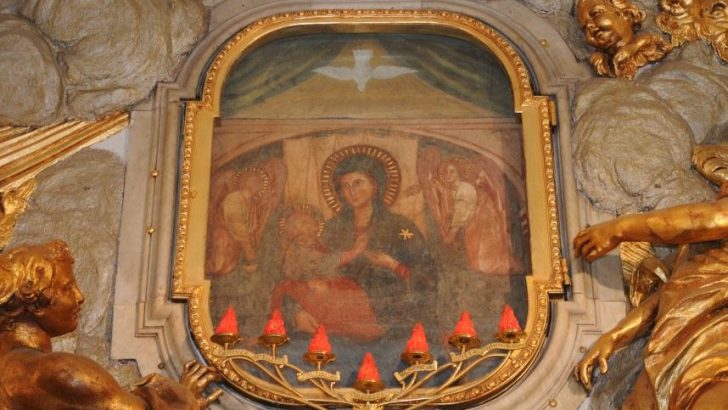The Notebook
Fr Bernard Healy
The whole Catholic world comes on pilgrimage to Rome, but where do the Romans themselves go on pilgrimage? Many head to Lourdes, Fatima and San Giovanni Rotondo like the rest of us, but the pilgrimage site that has a special place in the hearts of many Romans is Divino Amore, the Sanctuary of Our Lady of Divine Love at Castel di Leva, a little under 10 miles from the centre of the city.
Devotion to the image of Our Lady and the Child Jesus with the Holy Spirit at the shrine [pictured] began in 1740; a pilgrim on his way to Rome got lost in the countryside. Spotting the tower of Castel di Leva, he made his way towards it in search of directions.
Drawing near, he was set upon by a pack of wild and angry dogs. Fearing for his life, his eyes fixed on the sacred image painted on the tower and he cried out to Our Lady for help. Immediately and miraculously, the crazed hounds stopped their pursuit and withdrew, whilst some nearby shepherds came shortly afterwards to put the pilgrim on the right path.
He spread the story of his escape as he made his way to Rome, and people began to flock to the site which quickly obtained fame for graces received. Eventually a chapel and a shrine would be built.
Pilgrimage
From the Second Sunday of Easter until October, there is a candlelit pilgrimage on foot from the city to Divino Amore, departing at midnight and arriving at the shrine in time for 5am Mass.
It begins with the noise of the city all around, but a few minutes’ walk brings us to a quiet and ancient stretch of Roman road leading under the Arch of Drusus, through the city walls and onto the famous Appian Way, flanked by old Roman Villas, pagan sepulchres and the catacombs where the early Christians were laid to rest. We stop at the Ardeatine Caves and remember the 335 Italians shot there by the Germans; later we pause outside a hospital to pray for the sick.
With a night-time pilgrimage, there’s no sightseeing or idle conversation – you have just enough light to negotiate the next step or two in front of you. All you hear is the sound of prayer, the tramping of feet and the noise of birds, livestock and dogs from nearby fields and woods.
The farmsteads, villages and suburbs that make up the surrounding world slumber whilst the band of pilgrims makes its way through the night, praying and interceding, intent on a designation it cannot see, sustained by the quiet comradeship of a shared goal. The beauty of it is that one is both alone with God and yet supported by the presence of fellow pilgrims and the intercession of Our Lady.
The Second Vatican Council is fond of using the image of a pilgrimage to describe what it is to be part of the Church – a night-time trip to Divino Amore certainly gives reality to that image.
Uncared for
Like Knock’s Msgr Horan, the name of Fr Umberto Terenzi must be mentioned when discussing the Sanctuary of Divino Amore. Aged 30, he was appointed as Rector and first parish priest at the shrine in 1930 after decades of neglect. He found the little chapel in a disgraceful state, so uncared for that he couldn’t even find a clean purificator for the celebration of Mass.
Downhearted, in early 1931, Fr Umberto hopped into his car to drive back to Rome with the intention of never returning to the shrine again. As he left, his car overturned and was utterly wrecked, whilst he escaped without a scratch. He took that as a sign!
He would serve at the shrine until his death in 1974, and is largely responsible for the shrine becoming an extraordinary place of prayer, evangelisation and charitable works.
Our Lady doesn’t mess around.
***
Pray al fresco
One of the most unusual churches in the world is to be found at Divino Amore. Despite being open-air, the chapel of Blessed Ceferino Giménez Malla is officially recognised by the Diocese of Rome as a church.
The ground plan resembles the wheel of a horse-drawn caravan because it is the church of the gypsy people.
Blessed Ceferino was a member of the Romany people who lived in Spain and served the church as a catechist.
During the Spanish Civil War he was arrested by Republican Forces for attempting to defend a priest from them and was executed with the words “long live Christ the King” on his lips.


 Madonna del Divino Amore aka Our Lady of Divine Love, Rome, Italy
Madonna del Divino Amore aka Our Lady of Divine Love, Rome, Italy 